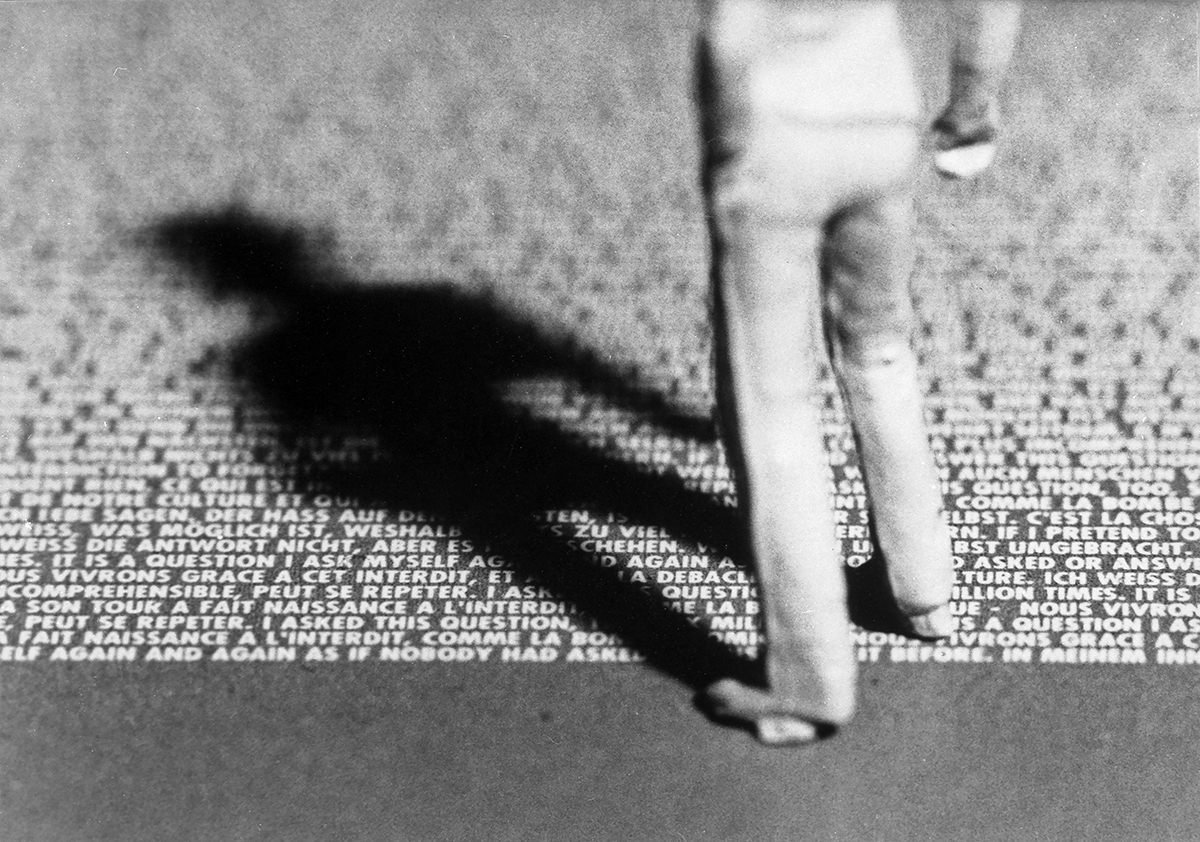Warum. Warum ist es geschehen?
Why. Why Did it Happen?
Denkmal für die ermordeten Juden Europas / Memorial to the Murdered Jews of Europe
CR 127. Year 1997

1997 - Rede an die Jury des Denkmals für die ermordeten Juden Europas, Jochen Gerz
It is surely a unique feature of our aimless age that we fully accept the utility of asking questions without any hope of receiving a reply. … Gerz invites the participants into a space of questioning and simply leaves them there.
Lawrence Rinder 1999
Gerz is not only concerned with memory as a form of cultural knowledge. For him, memory is rather the mainspring of human uncertainty and self-questioning. And it is only in this continual and self-induced uncertainty that there is, paradoxically enough, a chance of developing a self-awareness that is not in permanent danger of degenering into self-deception, whether in the form of a superiority complex or an inferiority complex. Historically, self-deception has always had catastrophic social consequences, and so, according to Gerz, it is not just a matter of remembering, but above all one of making memory relevant to the present situation and of gaining insight into its fundamental importance of an ethics for the future is to be developed.
Friedemann Malsch 2002
This artist has long been committed to destabilising and shattering the sense of contemporary art, asking questions without any intention of providing answers, yet finding a possible way forward in doing and acting. A route plotted by Dada, which perhaps still influences contemporary art's various attempts at sense or nonsense.
Roberta Valtorta 2008
Gerz développe une œuvre paradoxale sur le terrain de l’histoire de l’Europe et de la politique européenne. En apparence, il prend en charge les victimes de notre histoire contemporaine. En fait, il va au cœur de la question de la commande publique. On pourrait ainsi penser qu’il participe à l’actuel courant de victimisation, mais son geste est tout autre ; il dit, à propos des victimes, des disparus : « Ne nous occupons pas d’elles, il est trop tard pour elles. Occupons-nous de nous. »
Jean-Louis Déotte 2018
Therefore, Warum does not have the status of a question but instead introduces the question of questioning everything – a permanent, eternal question –
Mark Callaghan 2020
Categories
Keywords
Competition entry for a work in public space (Berlin, not realized)
14,500 m2 concrete surface for engraved texts, 39 light poles displaying words from luminous light-wave conductors, building Das Ohr / The Ear (design: Narsrine Seraji).
Following a ten-year discussion about the representation of the memory of the Shoah, a second, restricted competition for a Memorial to the Murdered Jews of Europe is announced in the spring of 1997. More than 800 artists take part in these competitions.
Jochen Gerz plans to dedicate the grounds to its visitors. They are to be invited to offer answers to the question most often asked (Why did it happen?).
39 light poles light up the grounds, displaying the word Why in the 39 languages spoken by the persecuted Jews of Europe. The answers of the visitors of the memorial are to be engraved one-by-one in the surface of the square until, several decades later, it is covered with text. The answers are collected in the building called Das Ohr (The Ear).
The participatory concept of Gerz is one of the four finalists of the competition.
Exhibitions
Berlin 1998. Bolzano 1999
Bibliography
I: Bolzano 1999 pp. 36, 80-85. Zürich 2000, p. 55, Vienna 2016, pp. 51-53, Ivry-sur-Seine 2017, pp. 188-189, 218
II: Beaucamp 1997. Gerster 1997. Haase 3, 1997. Red. 1, 1997. Roll 1997. Schlappner 1997. Schmid 1997. Wiedemann 1997. Berliner Morgenpost 20.3.1998. Buttlar/Endlich 1998, pp. 97-102. Clewing 1998. FAZ 19.1.1998. Fricke 1998. Gerz 1998. Haase 1998, pp. 492-493. Kuhn 1998. Naumann 1998. Pfütze 1998. Robin 1999. Schmid 1998, p. 4. Schwerfel 1999. Ullrich 1998. Verrier 1998. Young 1998, p. 56
III: Däniken 1997. Fricke 1997. Lücke 1998. Metzel 1998. Schmidt 1998, p. 33
V: Widrich 2014, pp. 170-178. Callaghan 2020, pp. 195-247